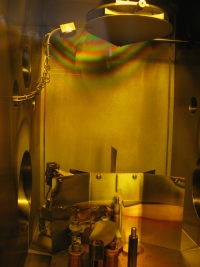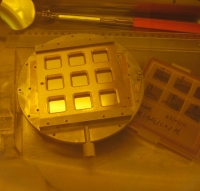« Evaporation zone » : différence entre les versions
Aller à la navigation
Aller à la recherche
(création à partir du texte français (fin)) |
(suppression du texte en français) |
||
| Ligne 18 : | Ligne 18 : | ||
<li>Vacuum during deposition: 2-6·10<sup>-6</sup> mbar</li></ul></td> |
<li>Vacuum during deposition: 2-6·10<sup>-6</sup> mbar</li></ul></td> |
||
<td>[[Image:Evaporateur1Red2.jpg|right|200px|Evaporator of the glove box]]</td></tr></table> |
<td>[[Image:Evaporateur1Red2.jpg|right|200px|Evaporator of the glove box]]</td></tr></table> |
||
<table border="0" cellpadding="5" cellspacing="1" style="width: 100%;"> |
|||
<tr><td><p>La zone évaporation du système de boîtes à gants contient un évaporateur à effet Joule. Le matériau à déposer est placé dans un creuset qui est chauffé jusqu'à évaporation du matériau et il se dépose alors sur le substrat.</p> |
|||
<p>Comme la plupart des équipements de la plate-forme, l'évaporateur fait l’objet d’une activité de service ouverte aux autres laboratoires et aux entreprises. Les demandes peuvent simplement être adressées par courriel.</p> |
|||
<p><strong> Caractéristiques techniques</strong></p> |
|||
<ul><li>Marque Kurt J. Lesker, modèle Mini-Spectros</li> |
|||
<li>Sources :</li> |
|||
<ul><li>2 creusets pour des métaux (Al, Ag, MoO<sub>3</sub>, LiF, Ca, Ni, Au ...)</li> |
|||
<li>1 cellule de Knudsen pour les matériaux organiques</li></ul> |
|||
<li>Épaisseur du dépôt : variable selon le matériau déposé, contrôlée par une balance à quartz</li> |
|||
<li>Taille des échantillons : 20 mm de côté</li> |
|||
<li>Nombre maximal d'échantillons : 9</li> |
|||
<li>Vide avant le dépôt : jusqu'à 10<sup>-7</sup> mbar</li> |
|||
<li>Vide pendant le dépôt : 2-6·10<sup>-6</sup> mbar</li></ul></td> |
|||
<td>[[Image:Evaporateur1Red2.jpg|right|200px|Évaporateur de la boîte à gants]]</td></tr></table> |
|||
<table border="0" cellpadding="5" cellspacing="1" style="width: 100%;"> |
<table border="0" cellpadding="5" cellspacing="1" style="width: 100%;"> |
||
| Ligne 41 : | Ligne 25 : | ||
<li>inorganic buffer layers </li> |
<li>inorganic buffer layers </li> |
||
<li>layers of small organic molecules</li> |
<li>layers of small organic molecules</li> |
||
<li> ...</li></ul></td></tr></table> |
|||
<table border="0" cellpadding="5" cellspacing="1" style="width: 100%;"> |
|||
<tr><td>[[Image:PorteEchantillons2Red.jpg|center|200px|Porte-échantillons pour l'évaporateur de la boîte à gants]]</td> |
|||
<td><p><strong>Principales utilisations</strong></p> |
|||
<ul><li>contacts métalliques</li> |
|||
<li>couches tampons inorganiques</li> |
|||
<li>couches de petites molécules organiques</li> |
|||
<li> ...</li></ul></td></tr></table> |
<li> ...</li></ul></td></tr></table> |
||
Version du 25 août 2016 à 07:56
Head: Daniel MATHIOT, Contact
The evaporation zone of the glove boxes system contains a Joule effect evaporator. The material to be deposited is placed in a crucible that is warmed until evaporation of the material which is then deposited on the substrate. Like most of the equipments of the platform, the evaporator is included in a service activity open to other laboratories and to companies. Applications can be simply sent by e-mail. Technical characteristics
|
Main uses
|





